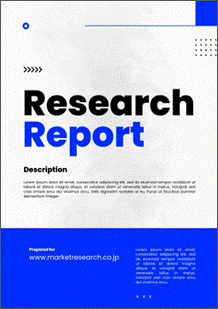 | • レポートコード:BONA5JA-0373 • 出版社/出版日:Bonafide Research / 2024年2月 • レポート形態:英文、PDF、62ページ • 納品方法:Eメール • 産業分類:化学&材料 |
| Single User(1名様閲覧用、印刷不可) | ¥333,000 (USD2,250) | ▷ お問い合わせ |
| Corporate License(閲覧人数無制限、印刷可) | ¥703,000 (USD4,750) | ▷ お問い合わせ |
• お支払方法:銀行振込(納品後、ご請求書送付)
レポート概要
トウモロコシ、サトウキビ、小麦などのバイオマスから生産されるアルコールの一種であるエタノールは、自動車、医薬品、飲料、化粧品など、さまざまな分野で重要な役割を果たしています。日本では、エタノールはアルコール飲料やパーソナルケア製品の製造だけでなく、ガソリンへのバイオ燃料添加剤としても広く使用されています。日本におけるエタノールの歴史は、ダイナミックな進化を遂げてきました。第二次世界大戦前には工業用溶剤や燃料として使用されていましたが、戦後は石油ベースの代替品が台頭したため、その重要性は低下し、輸入への依存度が高まりました。しかし、2000年代からのバイオ燃料時代には、主にガソリンへの混合用としてエタノールを推奨する政府の奨励策により、再び活気を取り戻しました。最近の傾向では、環境にやさしい原料、先進バイオ燃料、および消毒剤やバイオプラスチックを含む多様な用途に焦点を当てた、持続可能性への重要なシフトが強調されています。同時に、環境意識の高まりやバイオ燃料の義務化や二酸化炭素削減目標を通じた政府の支援など、文化的な変化も市場を後押ししています。特に、医薬品や化粧品などの燃料以外の用途が急増しているほか、セルロース系エタノールや発酵技術の進歩に伴い、需要パターンが多様化しています。これは、日本のエタノール市場が継続的な成長と革新の準備ができている業界であることを示しています。
ボナファイド・リサーチが発表した調査レポート「日本エタノール市場の概況、2029年」によると、日本のエタノール市場は2024年から2029年にかけて年平均成長率(CAGR)5%以上で成長すると予想されています。日本のエタノール市場では、バイオ燃料の義務化、二酸化炭素排出削減目標、国内生産への補助金といった政府政策が極めて重要であり、持続可能な開発目標(SDGs)に後押しされた再生可能エネルギーや循環型経済への注目が高まっています。さらに、医薬品、化粧品、消毒剤などの燃料以外の用途におけるエタノール需要の高まりは、新たな成長の道筋を示しています。発酵、変換、原料処理における技術革新は、さらに効率性と競争力を高めます。しかし、国内生産量の限界、価格変動やサプライチェーンの混乱につながる輸入への依存、持続可能で費用対効果の高い原料の必要性、電気自動車や水素などの代替燃料との競争、先進技術や持続可能な原料生産に伴う初期投資コストの高さなど、依然として課題は残っています。
日本のエタノール市場は、いくつかの要因に基づいて区分されています。まず、原料別では、エタノールは主にトウモロコシ、サトウキビ、キャッサバなどの天然資源から生産されており、主にブラジルと米国からの輸入品が市場を支配しています。サツマイモやその他のデンプン源を利用する国内生産はわずかです。エチレン水和プロセスによる合成エタノール生産は、天然エタノールと比較してコストが高く、経済的な実現性が限られているため、ほとんど行われていません。次に、原料別の区分では、土地利用の変化や食糧安全保障に関する懸念に対処するために、キャッサバやサツマイモなどの代替デンプン源の探査が増加しているものの、デンプンを原料とするエタノール、特にトウモロコシを原料とするものが最大のセグメントとなっています。 サトウキビを原料とするエタノールは、主にブラジルから輸入されており、燃料用エタノールの需要を満たす上で重要な役割を果たしていますが、森林伐採や持続可能性に関する懸念から、その割合は減少しています。非食料源由来のセルロース系エタノールは、現在ではまだごくわずかですが、持続可能な成長の可能性を秘めており、コスト競争力と商業的実現性を高めるための研究開発が継続的に行われています。
第三に、エタノールの用途別産業では、主に政府のバイオ燃料義務化政策に従ってガソリンに混合されるETBE(エチル・ターシャリー・ブチル・エーテル)の使用を通じて、自動車および輸送部門でエタノールが利用されています。規制変更による需要への将来的な影響が予想されます。さらに、エタノールは清酒などのアルコール飲料や国際的なアルコール飲料、ハンドサニタイザーや香水などのさまざまな用途の化粧品、殺菌、抽出、医薬品の合成などの医薬品にも利用されており、ヘルスケア分野を原動力として着実な成長を見せています。最後に、燃料混合による区分では、エタノールの混合レベルは様々ですが、現在、E5が唯一義務付けられている混合レベルであり、将来的にはE10も検討されており、これによりエタノールの需要が大幅に増加する可能性があります。また、より高濃度の混合や、フレックス燃料車や直接エタノール燃料電池への将来的な応用の可能性についても、現在研究が進められています。
日本のエタノール市場における政策および規制の枠組みは、いくつかの主要な推進要因によって形作られています。まず、2013年の「再生可能エネルギーの固定価格買取制度」で制定されたバイオ燃料の義務化により、ガソリンへのエタノール混合が義務付けられ、現在は最低5%(E5)となっていますが、E10への引き上げも検討されています。さらに、2050年までにカーボンニュートラルを実現するという日本の公約が、エタノールなどの再生可能燃料の利用を推進する政策の後押しとなっています。政府のプログラムでは、先進バイオ燃料や国内エタノール生産技術の研究開発に対する財政支援を行っています。 混合用エタノールは、特定の燃料品質基準を満たし、生産、貯蔵、輸送の全過程において安全および環境に関する規制を順守することが義務付けられています。 義務付けられているわけではありませんが、持続可能性の実践を証明するために、持続可能なバイオマテリアル円卓会議(RSB)やBonsucroなどの国際認証がますます求められるようになっています。しかし、市場は、厳しい規制や低価格の輸入品との競争による国内生産能力の限界などの課題に直面しています。また、原料の持続可能性に対する懸念やインフラの限界も、より広範な導入の障壁となっています。現在の取り組みは、持続可能な原料の推進、E10対応ポンプの拡大、日本の生産者の市場アクセスを改善するための国際基準の調和に重点を置いています。
日本のエタノール市場は、支援政策、多様な用途、環境意識の高まりにより、大きな成長の可能性を秘めています。しかし、持続可能な長期的な発展のためには、原料の入手可能性、競争、国内生産に関する課題を克服することが不可欠です。
レポート目次目次
1. エグゼクティブサマリー
2.市場構造
2.1.市場考察
2.2. 前提
2.3. 制限
2.4. 略語
2.5. 情報源
2.6. 定義
2.7. 地理
3. 調査方法
3.1. 二次調査
3.2. 一次データ収集
3.3.市場形成と検証
3.4. 報告書の作成、品質チェックおよび納品
4. 日本のマクロ経済指標
5.市場力学
5.1. 主要調査結果
5.2. 主要動向 – 2021年
5.3.市場の推進要因と機会
5.4.市場の抑制要因と課題
5.5.市場動向
5.6. コビッド19の影響
5.7. サプライチェーン分析
5.8. 政策および規制の枠組み
5.9. 業界専門家による見解
6. 日本のエタノール市場の概要
6.1.市場規模(金額ベース
6.2.市場規模と予測(原料別
6.3.市場規模と予測(供給源別
6.4.市場規模と予測(用途別産業
7. 日本のエタノール市場の区分
7.1. 日本のエタノール市場、原料別
7.1.1. 日本のエタノール市場規模、でんぷん由来、2018年~2029年
7.1.2. 日本のエタノール市場規模、糖類由来、2018年~2029年
7.1.3. 日本のエタノール市場規模、セルロース由来、2018年~2029年
7.1.4. 日本のエタノール市場規模、その他、2018年~2029年
7.2. 日本のエタノール市場、供給源別
7.2.1. 日本のエタノール市場規模、天然、2018年~2029年
7.2.2. 日本のエタノール市場規模、合成、2018年~2029年
7.3. 日本のエタノール市場、最終用途産業別
7.3.1. 日本のエタノール市場規模、自動車および輸送用、2018年~2029年
7.3.2. 日本のエタノール市場規模、アルコール飲料、2018年~2029年
7.3.3. 日本のエタノール市場規模、化粧品、2018年~2029年
7.3.4. 日本のエタノール市場規模、医薬品別、2018年~2029年
7.3.5. 日本のエタノール市場規模、その他別、2018年~2029年
8. 日本のエタノール市場機会評価
8.1. 原料別、2024年~2029年
8.2. 供給源別、2024年~2029年
8.3. 最終用途産業別、2024年から2029年
9. 競合状況
9.1. ポーターのファイブフォース
9.2. 企業プロフィール
9.2.1. 企業1
9.2.1.1. 企業概要
9.2.1.2. 企業概要
9.2.1.3. 財務ハイライト
9.2.1.4. 地域別動向
9.2.1.5. 事業セグメントおよび業績
9.2.1.6. 製品ポートフォリオ
9.2.1.7. 経営陣
9.2.1.8. 戦略的動きおよび展開
9.2.2. 企業 2
9.2.3. 企業 3
9.2.4. 企業 4
9.2.5. 企業 5
9.2.6. 企業 6
9.2.7. 企業 7
9.2.8. 企業 8
10. 戦略的提言
11. 免責条項
図表一覧
図1:日本におけるエタノール市場規模(2018年、2023年、2029年予測)(単位:10億米ドル)
図2:原料別市場魅力度指数
図3:供給源別市場魅力度指数
図4:エンドユーザー産業別市場魅力度指数
図5:日本エタノール市場のポーターの5つの力
表一覧
表1:2023年の日本エタノール市場に影響を与える要因
表2:日本エタノール市場規模および予測(原料別)(2018年、2023年、2029年予測
表3:日本エタノール市場規模および予測(供給源別)(2018年、2023年、2029年予測
表4:日本エタノール市場規模および予測 用途産業別(2018年、2023年、2029年予測)
表5:日本エタノール市場規模 デンプンベース(2018年~2029年) 単位:10億米ドル
表6:日本エタノール市場規模 糖質ベース(2018年~2029年) 単位:10億米ドル
表7:日本におけるセルロース系エタノール市場規模(2018年~2029年)単位:10億米ドル
表8:日本におけるその他エタノール市場規模(2018年~2029年)単位:10億米ドル
表9:日本における天然エタノール市場規模(2018年~2029年)単位:10億米ドル
表10:日本における合成エタノールの市場規模(2018年~2029年)
表11:日本における自動車および輸送用エタノールの市場規模(2018年~2029年)
表12:日本におけるアルコール飲料用エタノールの市場規模(2018年~2029年)
表13:日本のエタノール市場規模(2018年~2029年)の化粧品(単位:10億米ドル)
表14:日本のエタノール市場規模(2018年~2029年)の医薬品(単位:10億米ドル)
表15:日本のエタノール市場規模(2018年~2029年)のその他(単位:10億米ドル)
According to the research report "Japan ethanol Market Overview, 2029," published by Bonafide Research, the Japanese ethanol market is expected to grow with more than 5% CAGR from 2024 to 2029. In Japan's ethanol market, government policies such as biofuel mandates, carbon emission reduction targets, and subsidies for domestic production are pivotal, alongside the growing emphasis on renewable energy and the circular economy driven by Sustainable Development Goals. Moreover, increasing demand for ethanol in non-fuel applications like pharmaceuticals, cosmetics, and disinfectants presents new avenues for growth. Technological innovations in fermentation, conversion, and feedstock processing further boost efficiency and competitiveness. However, challenges persist, including limited domestic production, reliance on imports leading to price volatility and supply chain disruptions, the necessity of sustainable and cost-effective feedstock sources, competition from alternative fuels such as electric vehicles and hydrogen, and the high initial investment costs associated with advanced technologies and sustainable feedstock production.
The Japanese ethanol market is segmented based on several factors. Firstly, by source, ethanol is primarily derived from natural sources such as corn, sugarcane, and cassava, with imports mainly from Brazil and the United States dominating the market. Domestic production, which utilizes sweet potatoes and other starch sources, is minimal. Synthetic ethanol production through the ethylene hydration process is negligible due to higher costs and limited economic feasibility compared to natural ethanol. Secondly, segmentation by feedstock reveals that starch-based ethanol, particularly from corn, is the largest segment, although there is increasing exploration of alternative starches like cassava and sweet potatoes to address concerns about land-use change and food security. Sugarcane-based ethanol, primarily imported from Brazil, plays a significant role in meeting fuel ethanol demand, although its share is decreasing due to concerns about deforestation and sustainability practices. Cellulosic ethanol derived from non-food sources holds potential for sustainable growth, albeit currently negligible, with ongoing research and development efforts to improve its cost-competitiveness and commercial viability.
Thirdly, by end-use industry, ethanol finds application in automotive and transportation sectors primarily through the use of Ethyl Tertiary Butyl Ether (ETBE) blended with gasoline to comply with government biofuel mandates, with potential future impact on demand due to regulatory changes. Additionally, ethanol is utilized in alcoholic beverages such as sake and international alcoholic beverages, cosmetics for various applications like hand sanitizers and perfumes, and pharmaceuticals for sterilization, extraction, and synthesis of medicines, exhibiting steady growth driven by the healthcare sector. Lastly, segmentation by fuel blend reveals varying levels of ethanol blends, with E5 being the only mandated blend level currently, but considerations for E10 in the future, which could significantly increase ethanol demand, as well as ongoing research for higher blends and potential future applications in flex-fuel vehicles and direct ethanol fuel cells.
The policy and regulatory landscape of the Japanese ethanol market are shaped by several key drivers. Firstly, biofuel mandates, established in the 2013 Act on Promotion of Renewable Energy Sources, require blending ethanol into gasoline, currently set at a minimum of 5% (E5), with potential increases to E10 under consideration. Additionally, Japan's commitment to achieving carbon neutrality by 2050 is propelling policies supporting the use of renewable fuels like ethanol. Government programs offer financial support for research and development of advanced biofuels and domestic ethanol production technologies. Regulations dictate that ethanol for blending must adhere to specific fuel quality standards and comply with safety and environmental regulations throughout production, storage, and transportation. While not mandatory, international certifications like the Roundtable on Sustainable Biomaterials (RSB) and Bonsucro are increasingly sought after to demonstrate sustainability practices. However, the market faces challenges including limited domestic production capacity due to strict regulations and competition from lower-cost imports. Concerns over feedstock sustainability and infrastructure limitations also pose barriers to wider adoption. Current initiatives focus on promoting sustainable feedstocks, expanding E10-compatible pumps, and harmonizing international standards to improve market access for Japanese producers.
The Japanese ethanol market presents significant growth potential, driven by supportive policies, diverse applications, and increasing environmental consciousness. However, overcoming challenges related to feedstock availability, competition, and domestic production is crucial for sustainable long-term development.
